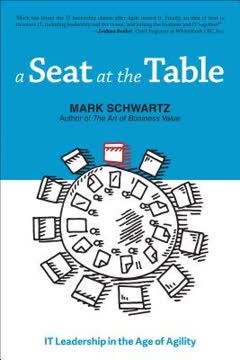Key Takeaways
1. IT must be integrated into the core of business strategy
To compete in a digital world, you must engage the IT department in determining and fulfilling business objectives.
Breaking down silos. The traditional model of IT as an arms-length service provider to the business is no longer effective. In the digital age, technology is central to how companies define themselves and compete. IT must be deeply involved in shaping business strategy and driving innovation.
Shared accountability. Rather than treating IT as a separate entity, organizations need to create cross-functional teams that include both business and technology expertise. These teams should be held accountable for business outcomes, not just for delivering on predetermined requirements.
Strategic value of IT. Leaders must recognize that IT investments can provide strategic benefits beyond immediate cash flows. This includes:
- Cultivating new growth opportunities
- Enhancing flexibility to respond to market changes
- Enabling faster innovation and time-to-market
- Deepening customer relationships through digital services
2. Agility is the key to success in the digital age
Risk is lack of agility.
Adapting to uncertainty. In a rapidly changing business environment, the ability to quickly respond to new circumstances is crucial. Agility allows companies to turn unexpected events into opportunities rather than threats.
Valuing flexibility. Organizations should prioritize investments that increase their agility:
- Building flexible, modular IT systems
- Adopting cloud infrastructure for scalability
- Developing workforce skills that support rapid adaptation
- Creating processes that allow for quick pivots in strategy
Continuous improvement. Agility isn't a one-time achievement but an ongoing process. Companies should constantly look for ways to reduce lead times, eliminate waste, and streamline decision-making processes. This enables them to experiment more freely, learn faster, and stay ahead of competitors.
3. Embrace uncertainty and complexity through experimentation
Instead of relying on analysis paralysis, it's often better to proceed on a small scale with a reversible decision, then quickly pivot if it doesn't work out.
Lean Startup approach. Rather than trying to plan everything in advance, companies should adopt a model of continuous experimentation:
- Identify key hypotheses about what will create value
- Design small, quick experiments to test these hypotheses
- Gather data and learn from the results
- Iterate or pivot based on what's learned
Minimum Viable Products (MVPs). Instead of building fully-featured products, start with the smallest version that allows you to test your core assumptions. This reduces risk and allows for faster learning and adaptation.
Data-driven decision making. Encourage a culture where decisions are based on empirical evidence rather than just intuition or hierarchy. This requires:
- Setting clear metrics for success
- Building systems to collect and analyze relevant data
- Creating feedback loops to quickly incorporate learnings
4. Shift from project-based to continuous, objective-driven delivery
Agility comes from the coordination of the three assets and suffers when there are arms-length handoffs between IT and the business.
Continuous delivery. Move away from large, infrequent releases to a model of constant, small improvements. This reduces risk and allows for faster adaptation to changing needs.
Objective-driven teams. Instead of organizing around projects with fixed requirements, create cross-functional teams focused on ongoing business objectives. This allows for greater flexibility and innovation in how goals are achieved.
DevOps practices. Adopt techniques that break down barriers between development and operations:
- Automated testing and deployment
- Continuous integration
- Infrastructure as code
- Rapid feedback loops
These practices enable faster, more reliable delivery of new capabilities.
5. Redefine governance and investment management for flexibility
Star Chamber governance is based on a mental model in which coarse-grained projects are vetted, compared, and given to IT for delivery. Oversight then focuses on making sure the plan that has been approved is executed. But this way of overseeing investment decisions does a poor job of supporting an organization's need for agility and continuous innovation.
Metered funding. Instead of approving large, upfront budgets, adopt a model of staged investments. This allows for:
- Lower initial risk
- Ability to pivot based on early learnings
- Opportunities to double down on successful initiatives
Objective-based governance. Move away from detailed requirements documents to high-level business objectives. Give teams the autonomy to determine how best to achieve these goals, while providing frequent oversight and guidance.
Portfolio management. Treat IT investments as a portfolio of options rather than fixed commitments. This mindset allows for:
- Greater flexibility in resource allocation
- Ability to quickly shift priorities based on market changes
- Balancing of risk across different types of initiatives
6. Cultivate a culture of innovation and security across the organization
A digital company is one in which every employee has the opportunity to be an entrepreneur.
Democratizing innovation. Create an environment where all employees feel empowered to suggest and test new ideas. This involves:
- Providing tools and platforms for experimentation
- Celebrating learning from both successes and failures
- Removing bureaucratic barriers to trying new things
Security as everyone's responsibility. In the digital age, security can't be left solely to IT. Foster a culture where:
- All employees understand basic security principles
- Security considerations are built into processes from the start
- There's a shared commitment to protecting customer data and company assets
T-shaped skills. Encourage the development of employees who have both depth in a specific area and breadth across multiple domains. This promotes:
- Better cross-functional collaboration
- More innovative problem-solving
- Greater organizational flexibility
7. Leverage cloud computing and AI for competitive advantage
The cloud developed from there. In addition to VMs, cloud providers also began to offer data storage for a fee. Each started replicating its infrastructure in multiple locations so that workloads would be resilient in the face of disasters. And the cloud providers began offering software capabilities in addition to infrastructure, with fees again based on usage.
Cloud-first strategy. Embrace cloud computing as a foundation for digital transformation:
- Scalability to meet changing demands
- Access to cutting-edge services and tools
- Reduced need for managing physical infrastructure
- Ability to experiment and innovate more quickly
AI and machine learning. Explore how these technologies can enhance your products, services, and operations:
- Personalization of customer experiences
- Predictive maintenance and optimization
- Automation of routine tasks
- Enhanced decision-making through data analysis
Data as a strategic asset. Invest in capabilities to collect, analyze, and act on data:
- Create data lakes for flexible analysis
- Implement real-time analytics for faster insights
- Use AI to uncover patterns and opportunities in large datasets
8. Transform the leadership team into a collaborative, cross-functional unit
A team has shared accountability for an objective, not individual accountability for separate functions.
Shared goals. Shift from siloed functional leadership to a model where the entire C-suite is collectively responsible for overall business outcomes. This promotes:
- Better alignment of initiatives across departments
- More holistic decision-making
- Faster response to cross-functional challenges
T-shaped leadership. Encourage executives to develop broad knowledge beyond their specific domains. This enables:
- More effective collaboration
- Better understanding of trade-offs and interdependencies
- Ability to spot opportunities that span traditional boundaries
Continuous adaptation. The leadership team should model the agility they want to see in the rest of the organization:
- Regularly reassess and adjust strategic priorities
- Embrace experimentation and rapid learning
- Foster open communication and challenge assumptions
Last updated:
Review Summary
War and Peace and IT receives mostly positive reviews, with readers praising its insights on digital transformation, agile methodologies, and the role of IT in business. Many find it well-written and informative, appreciating the author's experience and perspective. Some criticize the book for repetition and AWS bias. Readers value its exploration of IT's importance in determining business objectives and fostering collaboration. The book is recommended for executives and managers seeking to understand IT's role in driving business results, though some found it challenging to grasp certain concepts.
Similar Books










Download PDF
Download EPUB
.epub digital book format is ideal for reading ebooks on phones, tablets, and e-readers.






